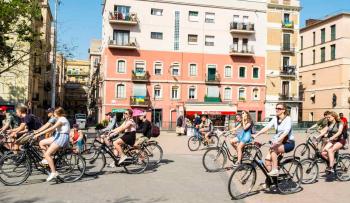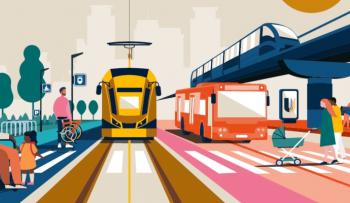
Combining cycling and public transport in the Eternal City: How the UPPER project brings solutions to Rome’s mobility challenges
High motorisation rates, low shares of active mobility and public transport present challenges to Rome’s current transport system. However, this is set to change soon: Led by the Sustainable Urban Mobility Plan and coordinated through the UPPER project, it is expected to set the city on a path to healthier and more climate-friendly mobility patterns.
The "Eternal City” Rome is well known for its historical sites, but also for its eternal traffic jams. As the country’s most populated area and an important economic centre, the capital strains to cope with accommodating approximately 10 million tourists per year, and in 2025 the number is expected to radically increase with the Jubilee of the Catholic Church.
All these factors create high demand within the mobility system, a demand which, up until now, has mostly been met through individual motorised transport. The motorisation rate is pretty high (640 vehicles per 1,000 inhabitants, with the EU average being 567 vehicles per 1,000 inhabitants), while public transport and walking shares are well below the average of 83 major European cities according to a recent survey by the European Commission. For cycling, Rome is even at the very bottom of the list in this report, with only 5% of respondents using cycling in central areas as one of their main modes of transport during a typical day, compared to a European average of 14%.
Starting from this baseline, the city has made ambitious plans to move towards a more efficient and sustainable mobility system. The Sustainable Urban Mobility Plan (SUMP) was approved at the beginning of 2022. Rome will use both EU structural funds, money from the Recovery and Resilience Facility in NextGenerationEU as well as national funds to develop infrastructural mobility projects linked to the SUMP objectives.
The Horizon Europe project UPPER, in which ECF is a partner, supports this process by coordinating the integration of a number of innovative measures financed through different sources and focusing on enhancing the use of public transport, its connection with cycling and walking, and the implementation of zero-emission zones.

Key initiatives under the UPPER project include:
-
Redesign of urban space to promote active mobility, public transport and 30 km/h zones, including 100 kilometres of expansion of the cycling network, new bike parking mobility hubs and the introduction of 30 km/h zones to improve pedestrian access to public transport stops.
-
Introduction of incentive packages to support multimodality; leveraging Mobility Managers, institutions and schools to promote sustainable mobility habits, including cycling and sharing (alone or in combination with public transport);
-
Reduction in the use of private vehicles through the implementation of a pollution charging scheme in the city centre (23 km2);
-
Implementation of a low-emission zone that includes the city centre and its semi-peripheral surroundings (156 km2);
-
Offering new mobility services in multimodal interchange nodes, with amenities like Park & Ride spaces facilities and integrating public transport with more sustainable last-mile solutions such as bike-sharing;
-
Design and implementation of new public transport infrastructure (metro and tramway) for Mass Rapid Transport and renewal of the PT fleet;
-
Redesign of the public transport network and infrastructure for the introduction of new electric buses;
-
Developing the “Mobility as a Service” system that corresponds to the mobility patterns and needs of different user groups, including tourists: This will also include the integration of bike-sharing applications into MaaS;
-
Introducing advanced technologies in the city’s Mobility Management Centre to improve public transport efficiency and reliability.

Through these concentrated measures, Rome shows its commitment to creating more sustainable mobility patterns while simultaneously combining support measures for cycling and walking with the reduction of speed limits and policies aimed at reducing car traffic (LEZ, LTZ). These policies will benefit road safety and air quality, and at the same time, these are essential to support the mobility backbone system, contributing to the UPPER’s objective of increasing the modal split in favour of LPT to create a more liveable urban environment, therefore to the Zero Emissions Climate Plan just issued by the City.
In the words of Eugenio Patanè, Rome’s Deputy Mayor for Mobility:
“UPPER is an extraordinary opportunity for comparison with other European cities, with whom we share the commitment to sustainable mobility to change the habits, customs and culture of our cities regarding mobility.”

In addition to the development of urban cycling infrastructure, Rome’s recent approval of the “Great Bicycle Ring Road” (Grande raccordo anulare delle biciclette, Grab) shows great commitment to connecting landmark historical and monumental interest with the city's green spaces, parks and historic villas, with a circular route of about 50 km for cyclists and pedestrians, both Roman and tourists. In line with the UPPER measures, the “Grab” will also be an important piece of infrastructure for intermodality between cycling and public transport since it will connect to not less than four metro lines, five tram lines, and one urban and five suburban railway lines. The project was developed through a participatory process involving experts and relevant stakeholders, but also interested citizens. It was presented at the Velo-city conference in Lisbon in 2021.
At the 3rd General Assembly of the UPPER project in January 2024, Anna Donati, the President and CEO of Roma Mobilità, the city Mobility Agency, described the GRAB as:
“The Grab is a project of urban regeneration, a plan to reduce car use in favour of pedestrian and cycling accessibility that Rome greatly needs”.
From ECF’s perspective, Rome’s initiatives hold significant potential to make a real difference to a more sustainable urban mobility system. We are looking forward to their implementation within the framework of the UPPER project and beyond, and also to the monitoring and evaluation results to track the targeted modal shift towards more cycling, walking and public transport.
Contact the author
Recent news!
Upcoming events
Contact Us
Avenue des Arts, 7-8
Postal address: Rue de la Charité, 22
1210 Brussels, Belgium









